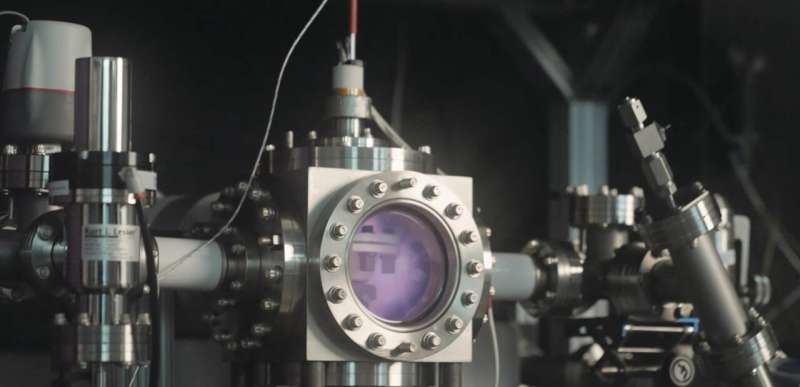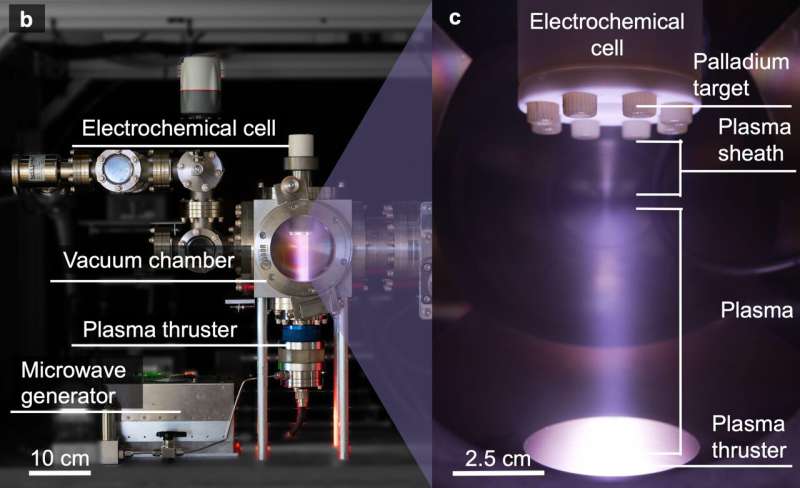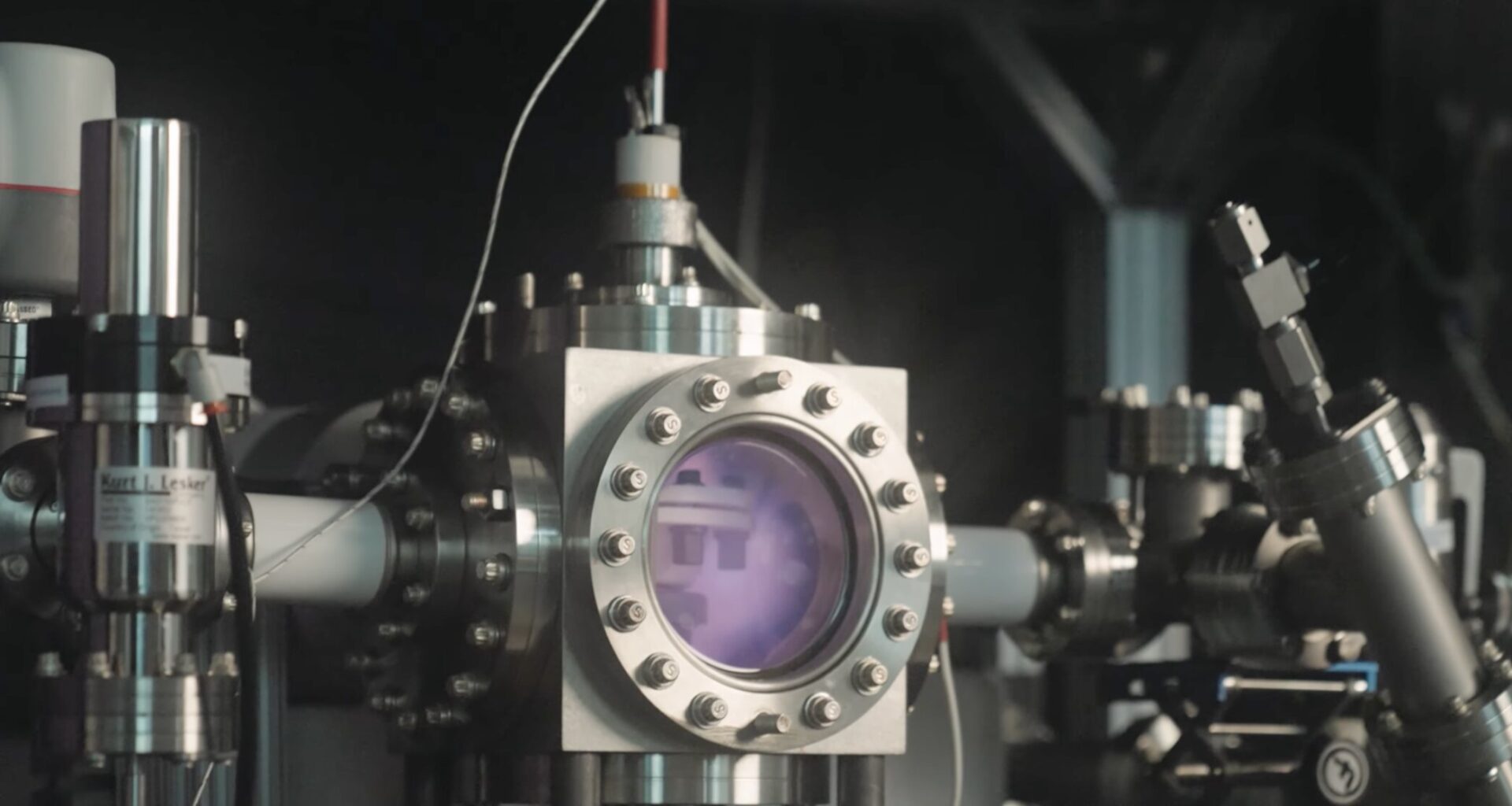
The Thunderbird Reactor is a custom-made, bench-top-sized particle accelerator and electrochemical reactor built by an interdisciplinary team at the University of British Columbia. Credit: University of British Columbia, Berlinguette Lab.
Using a small bench-top reactor, researchers at the University of British Columbia (UBC) have demonstrated that electrochemically loading a solid metal target with deuterium fuel can boost nuclear fusion rates.
Large-scale magnetic confinement fusion—which puts plasmas under extreme temperatures and pressure—is being widely explored as a method for clean energy generation. The experiment published in Nature takes an entirely different approach—with a more accessible, room-temperature reactor used to study the effect of electrochemical loading on nuclear fusion reaction rates.
The team loaded a metal target made of palladium with high concentrations of deuterium fuel on one side of the target, using a plasma field to load the fuel, and on the other, using an additional electrochemical cell to load the fuel.
“The goal is to increase fuel density and the probability of deuterium–deuterium collisions, and as a result, fusion events,” explains Professor Curtis P. Berlinguette, corresponding author of the paper and Distinguished University Scholar at UBC.
“Using electrochemistry, we loaded much more deuterium into the metal—like squeezing fuel into a sponge. One volt of electricity achieved what normally requires 800 atmospheres of pressure. While we didn’t achieve net energy gain, the approach boosted fusion rates in a way other researchers can reproduce and build on.”
The electrochemical loading of deuterium into the palladium target increased deuterium–deuterium fusion rates by an average of 15% compared to loading the target palladium using the plasma field alone.
While the performance boost is modest, it’s the first demonstration of deuterium–deuterium nuclear fusion using these techniques—plasma immersion ion implantation and electrochemical loading. The experiment still used more energy than it created.
“We hope this work helps bring fusion science out of the giant national labs and onto the lab bench,” adds Professor Berlinguette.
“Our approach brings together nuclear fusion, materials science, and electrochemistry to create a platform where both fuel-loading methods and target materials can be systematically tuned. We see this as a starting point—one that invites the community to iterate, refine, and build upon in the spirit of open and rigorous inquiry.”
Nuclear fusion—energy released from combining atomic nuclei, as occurs in the sun—is more powerful than fission (splitting nuclei) and creates less dangerous radioactive waste.

The reactor combines a plasma thruster, a vacuum chamber, and an electrochemical cell designed to improve fusion rates at lower temperatures. Credit: University of British Columbia, Berlinguette Lab
The Thunderbird reactor
The Thunderbird Reactor is a bespoke bench-top-sized particle accelerator designed to electrochemically enhance deuterium-deuterium nuclear fusion rates. The three main components of the reactor are a plasma thruster, a vacuum chamber, and an electrochemical cell.
The first demonstration of deuterium–deuterium nuclear fusion dates to 1934, when researchers bombarded a target of solid metal, plated with deuterated material, with high-energy deuterium ions.
In 1989, researchers claimed that anomalous heat was generated during the electrolysis of deuterium oxide using a palladium cathode—attributing the heat to the nuclear fusion of deuterium ions.
The result could not be independently validated and cold fusion research was effectively banished from mainstream science. The new experiment did not measure heat—it measured hard nuclear signatures like neutrons, which are direct evidence of fusion.
Professor Berlinguette and his team’s most recent work builds upon their work with a previous multi-institutional “peer group” that was convened by Google in 2015 to re-evaluate cold fusion.
The peer group went public with their efforts through a Nature Perspective in 2019 titled “Revisiting the Cold Case of Cold Fusion.” They found no evidence to support cold fusion claims, but identified multiple lines of inquiry that merited further exploration.
More information:
Electrochemical loading enhances deuterium fusion rates in a metal target, Nature (2025). DOI: 10.1038/s41586-025-09042-7
Provided by
University of British Columbia
Citation:
Room-temperature reactor uses electrochemistry to boost nuclear fusion rates (2025, August 20)
retrieved 21 August 2025
from https://phys.org/news/2025-08-room-temperature-reactor-electrochemistry-boost.html
This document is subject to copyright. Apart from any fair dealing for the purpose of private study or research, no
part may be reproduced without the written permission. The content is provided for information purposes only.
